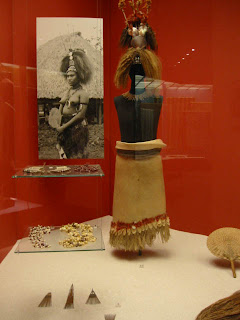
While on a courier trip in June, I had a chance to see this museum, which contains the collections of the now-closed
Musée national des Arts d'Afrique et d'Océanie and the ethnographic department of the
Musée de l'Homme. The museum opened in 2006 and contains 267,000 objects in its permanent collection, of which 3,500 items from the collection are on display.
The building is pretty interesting, designed by Jean Nouvel, and featuring a "vertical garden" by Patrick Blanc.

It's also surrounded by a lovely horizontal garden. And the interior starts out interestingly, with a snail- (or Guggenheim-) like ramp spiraling around an open storage area. This quickly deteriorates into a long, uphill slog, with little visual interest and way too many speeding children plunging down the straightaways. Once I finally reached the exhibit areas, I found them frustrating. The lighting levels are low, as appropriate for an ethnographic collection, but the dark walls and floors make it hard to see the artifacts clearly, even when all the lights are working, which was often not the case. (In the special exhibit on Paracas textiles, so many lights were out that it was impossible to see some of the most important artifacts, or many of the labels - I really wanted a flashlight.) All the more frustrating because there were some fantastic artifacts in their collections, including many from Claude Levi-Strauss's personal collection.

The wonderful artifacts were all too often not fully identified (no tribal affiliations for many of the Native American pieces, for instance) or were displayed in strange juxtapositions. For instance, one case included a Sioux warshirt, a Umatilla parfleche, an Acoma pot, a Chancay textile, and a Tiwanako stone block. The theme of the case (I tried guessing, without reading the labels, with no success) was "Duality of the Sexes" making a point about male art being figurative and female art abstract. !?!* It was like a post Grad course in Anthropology. And we think
our labels are too hard for our visitors! Did you know that beads and weaving are all metaphors for language? Or that "all containers evoke the idea of vitality, because living bodies are made of blood, flesh, bone, viscera, and a soul". Too ethereal for me - I just like looking at objects, so it was a relief to move on to their Crystal Skull, (labelled clearly as a modern fake but attracting a lot of adolescent attention).
The African collections were also wonderful but similarly hard to see and appreciate. I noticed glass shards in one of the cases, a result of using untempered plate glass vitrines, and having seams where visitors leaning on the glass would cause such damage. I spent several minutes trying to find a gallery attendant and trying to figure out how I could convey the message when I couldn't remember the French word for broken ('il y a quelque pieces du verre dans ce vitrine la'?) but finally gave up and decided to just be a tourist.
Final score Collections: A; Exhibit: C; Upkeep: F
Photography was not permitted but I got a *great* guide to the collections, full of color images, for only 15 Euros. Let me know if you'd like to have a look


 As in our Polynesian gallery, they make effective use of old photographs and prints to bring the object to life. They seem fine with using non-color images.
As in our Polynesian gallery, they make effective use of old photographs and prints to bring the object to life. They seem fine with using non-color images.
 My vote for one of the coolest artifacts ever: A Kiribat suit of armor. Pufferfish helmet and corselet, stingray spine gauntlets, shark tooth sword edge, woven coconut fiber mail. Warfare with Style!
My vote for one of the coolest artifacts ever: A Kiribat suit of armor. Pufferfish helmet and corselet, stingray spine gauntlets, shark tooth sword edge, woven coconut fiber mail. Warfare with Style!



